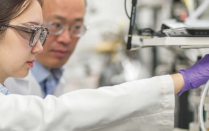UB engineers developing new polymer to escort cancer drugs with $2.4 million NIH grant

By Tom Dinki
Published March 30, 2023
You may not have heard of polyethylene glycol (PEG), but there’s a good chance you’ve ingested it.
The non-toxic polymer is commonly used to prevent freezer burn in ice cream, keep toothpaste moist and, more crucially, help cancer drugs reach their target and stay in the body longer.
PEG’s overabundance in food, cosmetics and pharmaceuticals can cause people to develop antibodies against it. In some cases, this can lead to allergic reactions and even reduced efficacy of PEG-coated drugs.
That’s why UB researchers are studying an alternative polymer to escort cancer medications into the body, known as zwitterionic polymer.
“The major advantage of zwitterionic polymer is immune response. Unlike PEG, there are currently no antibodies for zwitterionic polymers,” says Chong Cheng, professor in the UB Department of Chemical and Biological Engineering, within the School of Engineering and Applied Sciences (SEAS).
Cheng is the principal investigator on a $2.4 million grant from the National Institute of Biomedical Imaging and Bioengineering, one of the National Institutes of Health. Co-investigators are Yun Wu, associate professor in the UB Department of Biomedical Engineering, a joint program of SEAS and the Jacobs School of Medicine and Biomedical Sciences, and Eugene Y.-X. Chen, professor in Colorado State University’s Department of Chemistry.
During the four-year grant cycle starting April 1, the team will investigate whether zwitterionic polymer-drug conjugates (ZPDCs) can serve as a novel drug delivery system for medications treating pancreatic cancer, considered the deadliest kind of cancer in the human body.
“Our new ZPDCs address critical challenges faced by current drug delivery systems, such as PEG immunogenicity and co-delivery of drugs that have incompatible properties,” Wu says. “We can therefore provide more effective treatments for cancer patients and ultimately improve patient outcomes.”
Limitations of PEG-based drugs
Many targeted cancer therapies come in the form of small-molecule drugs, which have low molecular weight and can therefore enter cells more easily.
“But because small molecule drugs are so small, they are quickly filtered out through the kidney,” Cheng says. “So they have a quite narrow therapeutic window to treat the disease.”
PEG consists of large, water-soluble molecules, so drug manufacturers attach it to certain medications like cancer drugs in a process called PEGylation. This shields the medication from being broken down before it can reach its target and prolongs its circulation in the bloodstream.
PEG’s ability as a moisturizing and stabilizing agent has also made it a popular additive to processed food and cosmetic products. The global PEG market is estimated to reach a value of $8 billion by 2030.

Yun Wu
While the U.S. Food and Drug Administration classifies PEG as “generally recognized as safe,” as much as 72% of people have detectable levels of anti-PEG antibodies, according to a 2016 University of North Carolina study.
Just a small fraction have enough antibodies to put them at risk of an allergic reaction, the study found, but those who do can suffer rashes, hives and difficulty breathing.
PEG antibodies may have led a small number of people to experience allergic reactions to Moderna and Pfizer-BioNTech’s mRNA COVID-19 vaccines, which both use PEG to stabilize its lipid nanoparticles. The Centers for Disease Control and Prevention recommend those with a PEG allergy not receive an mRNA COVID vaccine.
In addition to causing allergic reactions, PEG antibodies can prevent PEGylated medications from doing their jobs.
“The PEG antibody will push out a PEG agent from the biological system, and efficiency of that delivery system would be greatly restricted,” Cheng says. “That's a major limitation of PEG-based therapeutics.”
Substituting with ZPDCs
There are currently no ZPDCs on the market. Based on a successful proof-of-concept demonstration, the UB-led team will investigate ZPDCs through physicochemical, cellular and in vivo studies.
The work will be conducted in Cheng’s lab in the Department of Chemical and Biological Engineering and Wu’s lab in UB’s Cell, Gene and Tissue Engineering Center. Chen’s lab at Colorado State University, which Cheng notes has outstanding records of polymer synthesis, will synthesize special kinds of polymer backbone for the project.
Aside from a lack of immune response, there are other advantages to ZPDCs, too. Cheng says they have high levels of hydration that allow medications to stay in the body even longer than PEGylated medications.
“So our therapeutic window can be even wider,” he says.
And while most ZPDCs currently being researched are non-biodegradable, Cheng says his team has engineered their ZPDCs to be biodegradable.
“This is very relevant for biomedical applications, because otherwise the accumulation of ZPDCs in biological systems would result in side effects,” he says.
Cheng says PEG is still a good approach for most patients, but its continued broad use makes it all the more crucial to find a viable alternative.
“This is a good opportunity to work in some interesting directions, with the potential to benefit many people,” Cheng says. “This way, we increase their treatment efficacy to improve their health and quality of life."


